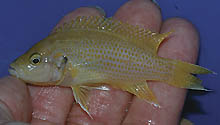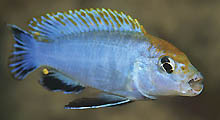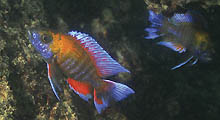WHAT'S NEW
ACROSS THE WORLD
Select date in side bar to go to a What's
New of previous issues
| What's New ©by
Laif DeMason
Summer is finally here and it is time to reorganize those fish tanks that need work. You have been putting the necessary chores off for some time now, so why not do it now? Maybe some of you are planning to go the this year’s American Cichlid Association convention in Milwaukee or a local club show and need to make room for any new purchases there. Whatever the case, new fish additions are always welcome, and can sometimes be unplanned. So make some more room by trading some grow out fry or condense some breeders that are not doing much. Either way it is always easier to fill up empty tank space than free up more space. A bit of planning can help. After all, no matter what size set up you have, who can turn down some new fish?
Here’s “what’s new” on the cichlid
scene:
|
Lake Tanganyika
The status quo remains in place over much of the lake. The price of fuel does not decrease and the bad economy does not help with any extra demand. Exporters, and thus collectors, continue to chase the latest hobbyist demands that are within financial reason. Current new interests include some hard to get items and some old time items not seen for ages but are reasonably nearby to harvest. No one fish item is making any strong new trends for now.
|
what's
new: Lake Tanganyika
|

The so-called black form of Altolamprologus calvus occurs along the Zambian and southern Congo coasts. Here, a black A. calvus collected in Congo exhibits an extreme black coloration even on its facial area. Often such coloration depends on mood.
|

Several of the shell dwelling cichlid species are of interest now. A recent arrival is Lamprologus brevis from Kapampa, Congo. Note the blue facial markings and white edging on the unpaired fins.
|

Also hailing from southern Congo, Neolamprologus helianthus is collected from a small coastal area due to its pleasing yellow highlights, though infrequently. Do not loose an opportunity to infuse some new blood into those old breeders!
|

An old time favorite from Burundi, Telmatochromis temporalis has been reintroduced. The last time this fish was exported regularly from Burundi was almost two decades ago. Talk about recycling your cichlids! What’s old is what’s new!
|
Lake Malawi
The way consumers buy Malawi cichlids has changed radically over time. Certainly, for the most part, in the beginning, people were just fascinated with them and wanted to see as many species as could be provided. After dozens of well-know species were imported, hobbyists learned of their aggression and their maternal mouthbrooding habits and thus wanted as many females as possible. Over the decades, breeding became less important to hobbyists and colorful males that were less aggressive were in vogue. Recently, less and less importance is given to wild type strains and more to the man-made varieties. The truly unusual is being sought.

Speaking of the truly unusual, Caprichromis orthognathus is a very colorful paedophage, devouring eggs and larvae after ramming brooding females over sandy habitat. I am sure in an aquarium it will eat most prepared foods! Photo by A. Konings. |

From the northern end of the Malawi coast, Copadichromis sp. 'virginalis chitande', is one of the few open water utakas offered for sale on a seasonal basis as wild-caught specimens. There are only a few types of C. virginalis actually bred for the commercial trade. Photo by A. Konings. |

Several of the big lipped species are regularly collected for export. Protomelas ornatus is sold under different names depending on its location and coloration. Here, P. ornatus sold as 'Chisumulu lobochilus'. Photo by A. Konings. |

An interesting mbuna type, Metriaclima sp. 'elongatus bee' from Katale, Malawi. There are a few Malawi cichlids that are named 'bee', however this one has very nice wide bars. Photo by A. Konings. |

A truly spectacular fish that is not often collected, Pseudotropheus perspicax from Mbowe Island, Malawi. I bred this 'orange-cap' perspicax for many years, but it was never a popular item. Photo by A. Konings. |

The original form of Aulonocara jacobfreibergi shipped in the 1970s is from Otter Point, Malawi. Now this location is part of Malawi National Park where collection is forbidden. Bred fish from the original wild strain, without any additional man-made changes, are still popular among hobbyists. Photo courtesy of www.wildcichlids.com. |
Lake Victoria
As often the case in this section, no news on wild collections can be reported. Victorian basin cichlids still are a popular item for many large aquarium retailers. Hopefully new material will one day appear. Until then, keep what you have and keep the wild strains pure!
West Africa
Not much news to report from the western countries in Africa. Many collectors and exporters find a tremendous lack of sales due the high costs of rounding up fish and selling them due to the lower demand in the current economic conditions. I wonder what stimulus can be applied here?
Neotropics
There is still much interest for fishes from the Americas. Perhaps it is the many American and other international hobbyists that go on collecting travels and trips that stimulate this market. Certainly there are enough countries to visit that have unique cichlids. Perhaps it is that many of the fishes from this region have been imported for decades and are thus well known and well bred. Whatever it is, there is still much interests in the cichlids from this region.

Recently imported for the first time from Guyana in small numbers, Crenicichla nickeriensis is thus one of the least commercially available pike cichlids. Photo by O. Lucanas. |

Produced in the Far East, this 'red texas' cichlid is a hybrid of different Central American species. Apparently, only a very, very few offspring of these crosses end up with the desired traits and thus command a very high price. |

Krobia sp. 'xingu' or sp. 'xingu orange' is an undescribed acara that has been imported off and on for several years. It has been available from breeders as well. This fish is a mild-mannered and large-growing cichlid with males reaching seven inches in total length. Photo by J. Rapps.
|

One of the more interesting and colorful discus, this pigeon blood discus bred in Germany exhibits a very pleasing large spot. Fascinating is all the many different and well established strains of discus that were unavailable only a few years ago!
|
Select date in side bar to go a What's
New of previous issues
|













